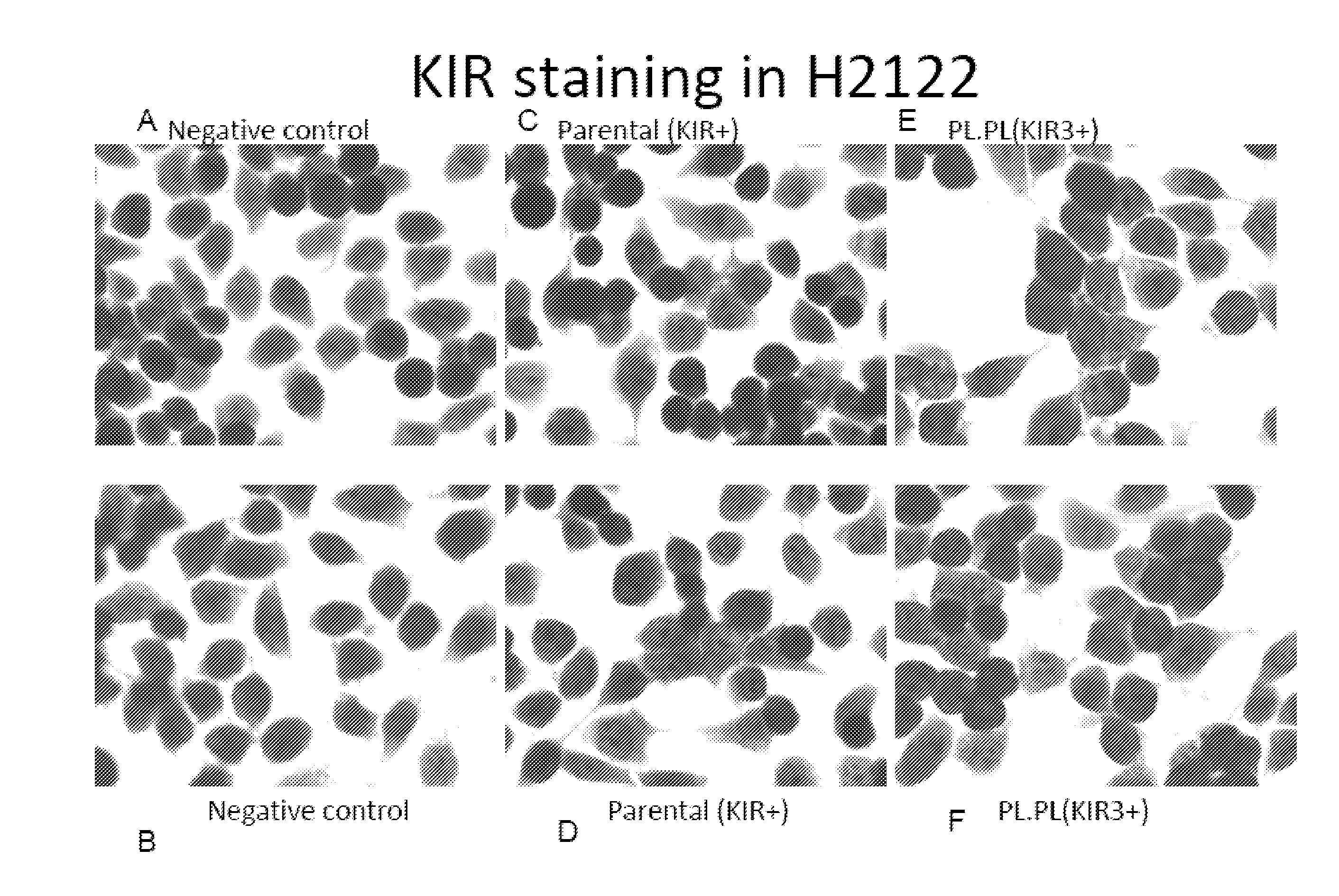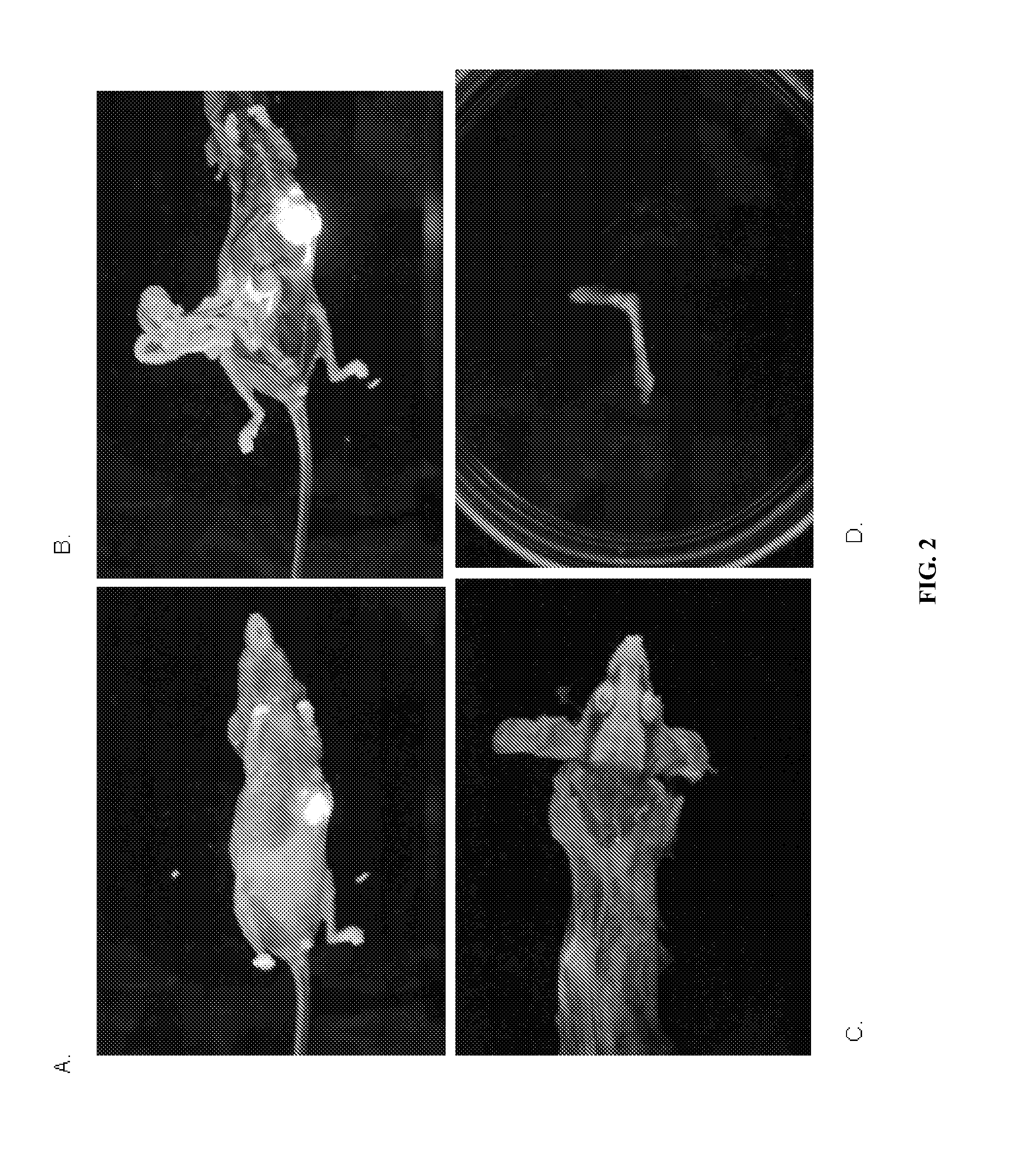Expression of kir in human cancer cells as a biomarker for immuno-escape and cancer metastasis
a human cancer cell and immuno-escape technology, applied in the field of immunology, oncology, genetics, etc., can solve the problems that the immune system has not been able to completely eradicate the progressing cancer cells, and achieve the effect of inhibiting kir activity, inhibiting kir's immuno-tolerance, and sensitive to nk cell killing
- Summary
- Abstract
- Description
- Claims
- Application Information
AI Technical Summary
Benefits of technology
Problems solved by technology
Method used
Image
Examples
example 1
Orthotopic Lung Model in Nude Rats
[0359]Method: H2122 (CRL-5985) is a hyperdiploid human lung adenocarcinoma (NSCLC), originally derived from metastatic pleural effusion (ATCC, Rockville, Md.). GFP-tagged H2122 was used to assess tumor growth and metastasis in athymic nude rats using a whole-body in vivo fluoresecent imaging system (Yang et al., 2001) Human lung cancer cell line H2122 adenocarcinoma was tagged with GFP (green fluorescent protein) and implanted subcutaneously in the rear flank or orthotopically in the left lung of athymic nude rats. In vivo fluorescent imaging was used to follow patterns of tumor growth and metastasis formation. When animals showed signs heavy breathing due to metastases, tumor tissues were isolated aseptically from primary sites of implantations, plus metastases in the right lung and distant metastases (FIGS. 1A-F). These tumors were mechanically disseminated and allowed to regrow again in tissue culture (FIGS. 3A-D). RNAs were isolated from these e...
example 2
Detection of KIR Gene Expression on H2122 Parental and Metastatic Cells
[0361]Methods: Gene and protein expression in KIR-expressed metastases isolated from different sites in the orthotopic lung model in nude rats and an equivalent melanoma models is examined in order to determine genes / proteins involved in the immuno-escape, tumor invasion and metastasis. DNA microarrays are used to analyze the metastatic cancer cells tagged with GFP and re-isolated from the orthotopic animal models. Experiments are carried out to examine protein and phosphoprotein targets of KIR, in metastatic cells from different sites of metastasis. Appropriate antibodies are used to validate the expression of the genes or proteins that are identified as of interest.
[0362]Rodent KLR receptors (Ly49) (equivalent to human KIR) are ectopically expressed in selected human lung cancer cells and determine if the resultant cell lines become more immuno-tolerant and gain metastatic features in athymic nude mice and nude...
example 3
Detection of KIR Proteins on H2122 Cells
[0367]To further confirm the elevated KIR protein expression, GFP tagged H2122 parental and metastatic cells were stained with commercial anti-KIR antibodies conjugated with APC fluorescent dyes (Miltenyi Biotec) and analyzed by flow cytometry. Four different KIR subtypes were used for the staining studies, which may reflect different KIR expressions among these H2122-GFP cell lines. Antibodies directed against KIR subtypes KIR2DL1, KIR2DL2, KIR3DL1 and KIR2DS4 were tested and found to be positive in the samples. The double positive cells (KIR+ and GFP+) were enriched using flow cytometry cell sorter. The KIR-enriched populations were re-stained with anti-KIR antibodies.
[0368]Among the four subtypes, anti-KIR2DL1 provided the strongest mean fluorescent intensity and reacted with a higher percentage of cells in all of the samples tested. The results are shown in FIGS. 10A-D. Only 2% positive cells were detected in parental H2122 cells, 15% in c...
PUM
| Property | Measurement | Unit |
|---|---|---|
| Volume | aaaaa | aaaaa |
| Volume | aaaaa | aaaaa |
| Volume | aaaaa | aaaaa |
Abstract
Description
Claims
Application Information
 Login to View More
Login to View More - R&D
- Intellectual Property
- Life Sciences
- Materials
- Tech Scout
- Unparalleled Data Quality
- Higher Quality Content
- 60% Fewer Hallucinations
Browse by: Latest US Patents, China's latest patents, Technical Efficacy Thesaurus, Application Domain, Technology Topic, Popular Technical Reports.
© 2025 PatSnap. All rights reserved.Legal|Privacy policy|Modern Slavery Act Transparency Statement|Sitemap|About US| Contact US: help@patsnap.com



